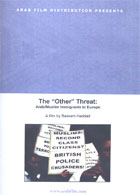
The “Other” Threat: Arab/Muslim Immigrants in Europe 2008
Distributed by Arab Film Distribution, 10035 35th Ave. NE, Seattle, WA 98125; 206-322-0882
Produced by Quilting Point Productions
Directed by Bassam Haddad
DVD, color, 78 min.
College - General Adult
Economics, European Studies
Date Entered: 10/11/2012
Reviewed by Michael J. Coffta, Business Librarian, Bloomsburg University of PennsylvaniaThis courageous work addresses the profoundly charged topic of immigration of Muslims into England and Spain, and the accompanying notion of balancing assimilation and multiculturalism. Proponents of loose immigration laws point to the skilled labor that immigration brings to these countries, while opponents point to growing mainstream ethnic tensions spurred by recent terrorist attacks and activities, forecasted housing problems, and the inflow of skilled labor that drives down labor costs, making it difficult for others to compete. The film also examines the issue of assimilation. Several official constituents as well as citizens at large state that there is an implicit obligation of immigrants to take on at least some of their new indigenous environment in order to make coexistence more feasible.
The film opens by discussing motives for and manners of illegal entry, with interviews with authorities and interviews with illegal immigrants. There is good presentation of data interspersed throughout the first half of this film, including exposition of the ethnic composition of European countries, and data on migrant and immigrant workers. The filmmakers offer balanced data supporting both sides of the immigration issue. The documentary conspicuously ramps up in intensity in its second half, with interviews of nearly incensed Muslims pointing to police brutality and religious persecution. The audience is presented with much less data, and much more filming of protests.
This documentary is robust and extremely well researched, admirably giving viewers a near comprehensive account of the issues at stake. The weaknesses, however, comes in its production and editing. The subtitles used throughout are often illegible, as they are superimposed over other lettering in the background. The filmmakers often use a unique, albeit questionable, two-camera approach in which a speaker presents his/her position, while an opponent is viewed listening intently and subsequently responds. While this side by side, asynchronous, pro/con approach is creative, there is little value added with this camera work. The listening party is viewed while he/she is inevitably setting nearly motionless. Although potent, the second half suffers from all too frequent insertion of the film’s title sequence music. In one instance, this musical snippet is actually inserted into a Muslim spokesman’s discourse midsentence, only to resume the discourse after the music is complete.
This film does not shy away from confronting provocative and often divisive topics. Audiences will feel very much in touch with the issues, costs, stakes, and ferment associated with Muslim immigration into Spain and England.